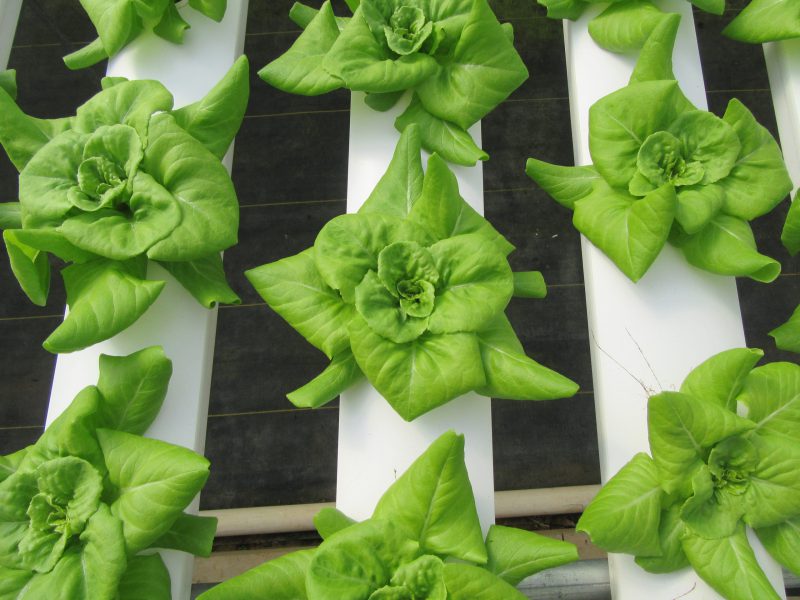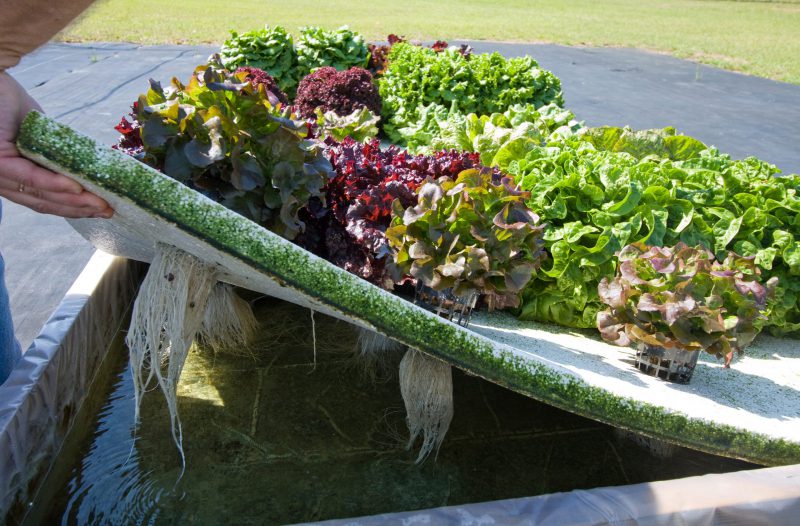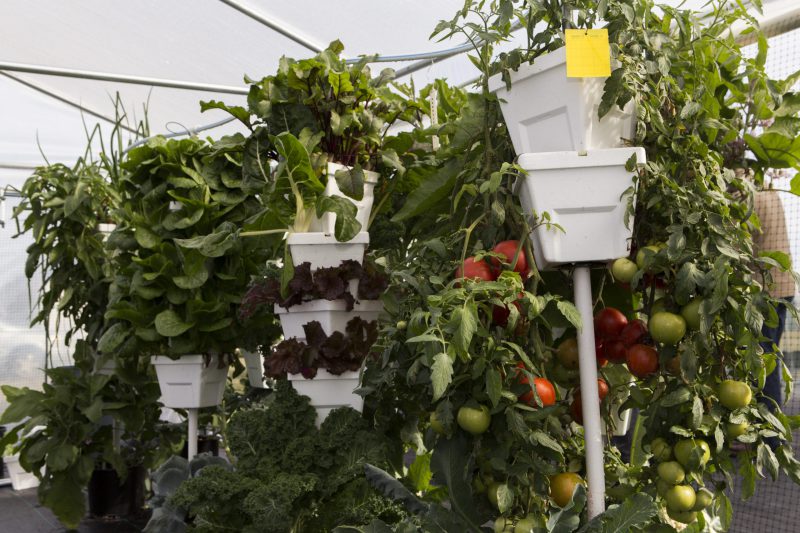If you are considering diversifying your farm, or simply planning to grow more produce at home, then you may want to give hydroponic production a try. Basically, hydroponic production is the growing of crops without soil. This can be achieved through several methods: growing crops in a nutrient solution; growing crops in a trough of running water; or growing crops in soilless media.
Hydroponic Growing Systems
-
Floating Raft Systems
Floating rafts are probably the most literal and simple hydroponic systems. These systems utilize a floating mat system most commonly made of polystyrene, in which holes are drilled. The raft supports the crop in a pool of nutrient solution. This system works well with crops that grow well in high-moisture conditions, such as lettuce, basil, and watercress. The nutrient solution pool can consist of a container as small as a 5-gallon bucket, a kiddie pool, or a 2″X12″ lumber walled raised bed lined with a pool liner. For more information on building a floating raft system, please visit the publication: “Building a Floating Hydroponic Garden“.
–
-
Nutrient Film Technique (NFT)
The nutrient film technique (NFT) uses no media. Instead, plants are grown in a flowing nutrient solution in a small trough (similar to a house gutter) or a PVC pipe. The nutrient solution is held in a tank (a large storage container is used for smaller systems) and recirculated through the growing troughs with a pump. This system works well for lettuce, basil, and watercress, but larger troughs can be used for tomato production. For more information on growing lettuce hydroponically, please visit the publication: “An Overview of Lettuce Production Systems and Cultivars Used in Hydroponics and Protected Culture in Florida“.

Lettuce growing in an NFT system. Photo Credit: Evan Anderson, University of Florida/IFAS Extension – Walton County.
–
-
Media Production
Soilless media is used in many different hydroponic systems. The most common media types are perlite, composted pine bark, rockwool, and coconut coir. These products are utilized in containers of all shapes from round nursery pots, lay flat bags, and stackable containers that form towers.
-
Media Filled Nursery Pots/Bag Culture
In this system, pots are lined up in rows and filled with composted pine bark, perlite, or vermiculite. Microjet or drip irrigation lines are used to water and fertilize the crop. Nutrients are not normally recirculated in these systems, however a number of manufacturers produce a “Dutch bucket” product that allows for nutrient runoff to be collected and reused. For more information on growing vegetables in nursery pots, please visit the publication: “Growing Bell Peppers in Soilless Culture under Open Shade Structures“.
-
Lay Flat Bag Culture
In this system, long, narrow bags are filled with perlite, rockwool, or coconut coir. Microjet or drip irrigation lines are used to water and fertilize the crop.
-
Tower Culture
In this system, unique nursery pots are stacked to create a tower or containers are secured to a post. A lighter weight media such as perlite or vermiculite is generally used. Water and nutrients are pumped to the highest container(s) on the tower and the lower tiered containers receive nutrients and water from leaching due to gravity.
-
–
Fertilizer Stock Tanks
In commercial scale hydroponic production systems, at least two fertilizer stock tanks are necessary. Calcium nitrate is mixed in the first tank, and the second is used to mix all nutrients needed other than calcium. Some growers purchase “premix” products for this second tank, but larger operations usually choose to mix their own ingredients to save money. A separate tank is used for calcium nitrate to prevent calcium carbonate precipitation, due to a reaction with ammonium containing fertilizers. After concentrated nutrients are diluted with water in the stock tank, the mix is injected into the water line that goes to the irrigation system. For more information on nutrient mixing guidelines, please visit the publication: “Nutrient Solution Formulation for Hydroponic (Perlite, Rockwool, NFT) Tomatoes in Florida“.
Seasonal Considerations for Hydroponic Production
Although all the hydroponic systems described in this article can be operated outdoors, higher quality crops and increased yields can be achieved under cover. The construction of a greenhouse or other plastic covered structure is recommended for hydroponic production. Covered structures help protect crops from cold weather, humidity and precipitation, and from insect pests and diseases. During the summer months in Florida, heat, humidity, and pest pressure are too extreme to produce a successful crop under a protective structure. Commercial hydroponic growers usually take time during the summer to clean out their spring crop residue, and sanitize equipment in preparation for the fall growing season. However, some growers have been successful growing a summer crop outside of a protective structure. Some growers even install coolers in their stock tanks to extend the growing season into the summer.
Whether you’re looking to diversify your farming operation or just want to try it on a small scale to feed your family, hydroponic production may be something to dabble with. At the very least, you will have fresh produce for your family throughout the year!
- Santa Rosa Citrus Production Workshop –March 7 - February 23, 2024
- Hosting an On Farm Agritourism Event: Helpful Tips - February 16, 2024
- AFVGA Annual Conference & Trade Show – February 14-16 - December 8, 2023


